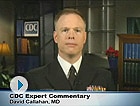We can control asthma
Over the past decade, the number of people with asthma in the U.S. has grown to about 25 million, or one out of every 12 people in the country. Every day, 9 Americans die from causes related to asthma. Asthma now costs the nation more than $50 billion every year. Learn how we can work together to control asthma.

Asthma is a lifelong disease that causes wheezing, breathlessness, chest tightness, and coughing. It can limit a person’s quality of life. Although asthma cannot be cured, most people with asthma can control their symptoms and prevent asthma attacks by correctly using medicine, such as inhaled corticosteroids, and by avoiding asthma triggers. Triggers for asthma can be found at school, work, home, outdoors, and elsewhere and can include tobacco smoke, mold, outdoor air pollution, and infections linked to influenza, colds, and other viruses.

‘Living With Asthma: CDC Vital Signs’external icon [2.08 minutes]
What does living with asthma mean to you?
Asthma does not affect everyone in the same way. More children (about 1 in 10) than adults (about 1 in 12) have asthma and, in 2008, children were more likely than adults to have an attack. Women were more likely than men and boys more likely than girls to have asthma. Non-Hispanic blacks had the highest rate of asthma among racial/ethnic groups in 2009, with 1 in 9 having the condition. The greatest rise in asthma rates was among black children (almost a 50% increase) from 2001 through 2009.
Asthma is also very expensive, for both individuals and the nation. Asthma education and services to reduce exposure to asthma triggers are often not covered by health insurers. In 2008, less than half of people with asthma reported being taught how to avoid triggers. Additionally, about 2 in 5 uninsured people with asthma can’t afford their prescription medication and only 1 in 9 insured people with asthma can’t afford it. Nationally, asthma cost the U.S. about $3,300 in medical expenses per person with asthma each year from 2002 to 2007, with medical expenses linked with asthma growing from $48.6 billion in 2002 to $50.1 billion in 2007. In 2008, children with asthma missed an average 4 days of school and adults with asthma missed an average 5 days of work.
Better asthma education is needed. People with asthma can prevent asthma attacks if they are taught how to use inhaled corticosteroids and other medicine correctly and how to avoid asthma triggers. An array of tools for people with asthma, parents of children with asthma, clinicians, and others to use in reaching these goals is available from CDC’s National Asthma Control Program (NACP).
What is CDC doing?

The NACP works to reduce the number of deaths, hospitalizations, emergency department visits, school or work days missed, and limitations on activities due to asthma. The NACP does this by developing and implementing evidence-based best practices that reduce asthma-related illness and death, and continually enhancing systems to monitor our progress. Currently, CDC funds grantees in 34 states, the District of Columbia, and Puerto Rico for 5 years to help CDC meet these goals and objectives. CDC works with these and other partners to:
- Track asthma and the effectiveness of control.
- Promote influenza and pneumonia vaccination for people with asthma.
- Work for improvements in indoor air quality through measures such as smoke-free air laws, healthy schools and workplaces for people with asthma, and improving outdoor air quality.
Learn what you can do to help control asthma
Asthma Awareness Month Digital Outreach Toolkit pdf icon[PDF – 1.71 MB]
Help spread the word about Asthma Awareness Month. This Digital Outreach Toolkit offers ideas and activities for you to use on your Web site, blog, or social media pages.
If you or your child has asthma you should:
- Receive ongoing appropriate medical care.
- Be empowered through education to manage asthma and asthma attacks.
- Avoid asthma triggers at school, work, home, outdoors, and elsewhere. Triggers for asthma can include mold, tobacco smoke, outdoor air pollution, and infections linked to influenza, colds, and other viruses.
- Use inhaled corticosteroids and other medicines correctly.

‘No Vacation From Asthma: Asthma Control During Travel’external icon [3:46]
Watch a new CDC video on preventing asthma attacks while traveling with expert commentary by David B. Callahan, MD.
We can all work with our local school systems and school nurses to:
- Encourage students with asthma to use inhaled corticosteroids and other medicines correctly and to avoid asthma triggers.
- Ensure that students’ inhalers are readily available for them to use at school as needed.
- Take steps to fix indoor air quality problems like mold and outdoor air quality problems such as idling school buses.
If you are an employer or an insurer you can:
- Promote healthy workplaces by reducing or eliminating known asthma triggers.
- Promote measures that prevent asthma attacks such as increasing access to inhaled corticosteroids and other prescribed medicines.
- Encourage home environmental and educational sessions conducted by clinicians, health educators, and other health professionals both inside and outside the clinical setting.